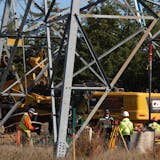PARK RAPIDS, MINN. – Leon Rogers has lived next to crude oil pipelines for years. He's had enough.
With four pipelines already buried beneath his farmland and a fifth one planned next to his house, Rogers and many of his neighbors are no longer ambivalent about the river of oil flowing through this region of forests, lakes and rivers.
"They are making it a freeway for pipelines," said Rogers, a registered nurse who has lived on a small farm south of Park Rapids for 18 years. "It comes down to, 'I don't want to live here.' "
Anti-pipeline sentiment is spreading in Minnesota's North Woods, where 14 percent of the nation's oil supply already flows through 10 cross-state pipelines leading to Superior, Wis., and the Twin Cities. It's happening amid persistent environmental opposition to the proposed Keystone XL pipeline, which would run from Alberta, Canada, through western U.S. states, and to a proposed copper-nickel mine near Minnesota's Boundary Waters Canoe Area Wilderness.
For years, pipeline companies like Enbridge Energy, based in Calgary, Alberta, have faced not-on-my-property opposition over new pipelines carrying Canadian and U.S. oil. Now, residents like Rogers and a new citizen group are asking: Should the Mississippi River headwaters be a major conduit for crude oil?
Enbridge is proposing to build the 610-mile, $2.6 billion Sandpiper pipeline across North Dakota and Minnesota to transport oil from the Bakken region to Superior. Part of the route passes Itasca State Park on a corridor that already has four crude oil pipelines owned by another company.
"This one has caught everyone's attention," said Willis Mattison, a former regional administrator for the Minnesota Pollution Control Agency who is advising a newly formed group called Friends of the Headwaters, which has challenged the project.
Two month after it formed, the Park Rapids-based group says hundreds of people have expressed support. In a sign of the anti-pipeline sentiment, a crowd of 130 people at a public meeting in Park Rapids Wednesday applauded everyone who spoke against the project. The lone supporter, a local bus driver, made his remarks to polite silence.


